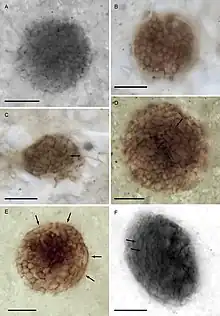Bicellum brasieri
| Bicellum brasieri Temporal range: | |
|---|---|
 | |
| Multiple specimens of B. brasieri, such as the holotype (A) | |
| Scientific classification | |
| Domain: | Eukaryota |
| (unranked): | Unikonta |
| (unranked): | Obazoa |
| (unranked): | Opisthokonta |
| (unranked): | Holozoa |
| Genus: | †Bicellum |
| Species: | †B. brasieri |
| Binomial name | |
| †Bicellum brasieri Strother et al. 2021 | |
Bicellum brasieri is a fossil holozoan.[1] It is about 1 billion years old and could be the oldest example of complex multicellularity in the evolutionary lineage leading to the animals.[2] It was discovered in 2021.[2]
Fossil site
Bicellum was found in sediments from the Diabaig Formation in Loch Torridon, Scotland. The Diabaig Formation, considered to represent an ancient lake deposit,[3] was already known to preserve the first non-marine eukaryotes.[4]
References
- ↑ Strother, Paul K.; Brasier, Martin D.; Wacey, David; Timpe, Leslie; Saunders, Martin; Wellman, Charles H. (April 2021). "A possible billion-year-old holozoan with differentiated multicellularity". Current Biology: S0960982221004243. doi:10.1016/j.cub.2021.03.051.
- 1 2 "Billion-year-old fossil found preserved in Torridon rocks". BBC News. 29 April 2021. Retrieved 2 May 2021.
- ↑ Stewart, A. D. (2002). The Later Proterozoic Torridonian Rocks of Scotland: their Sedimentology, Geochemistry and Origin. London: the Geological Society. pp. 1–136. ISBN 1-86239-103-3.
- ↑ Strother, Paul K.; Battison, Leila; Brasier, Martin D.; Wellman, Charles H. (May 2011). "Earth's earliest non-marine eukaryotes". Nature. 473 (7348): 505–509. doi:10.1038/nature09943. ISSN 1476-4687.
This article is issued from Offline. The text is licensed under Creative Commons - Attribution - Sharealike. Additional terms may apply for the media files.